Have you ever wondered which dinosaurs roamed the land that is now Nevada? Or do you simply want to journey back in time and explore an ancient landscape full of massive reptiles? If you live in Nevada or plan on visiting soon, prepare for a prehistoric adventure.
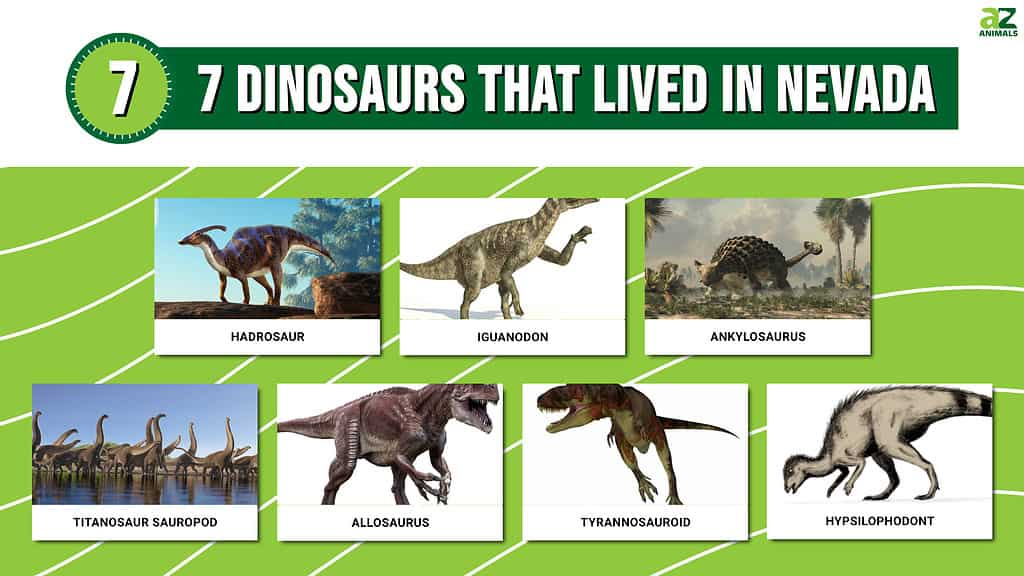
In this article, we’ll go back in time to discover seven amazing dinosaurs that once roamed Nevada and where you can find their fossilized remains today. So buckle up for an exciting journey through prehistory – it’s time to discover which dinosaurs called Nevada home.
1. Hadrosaurs
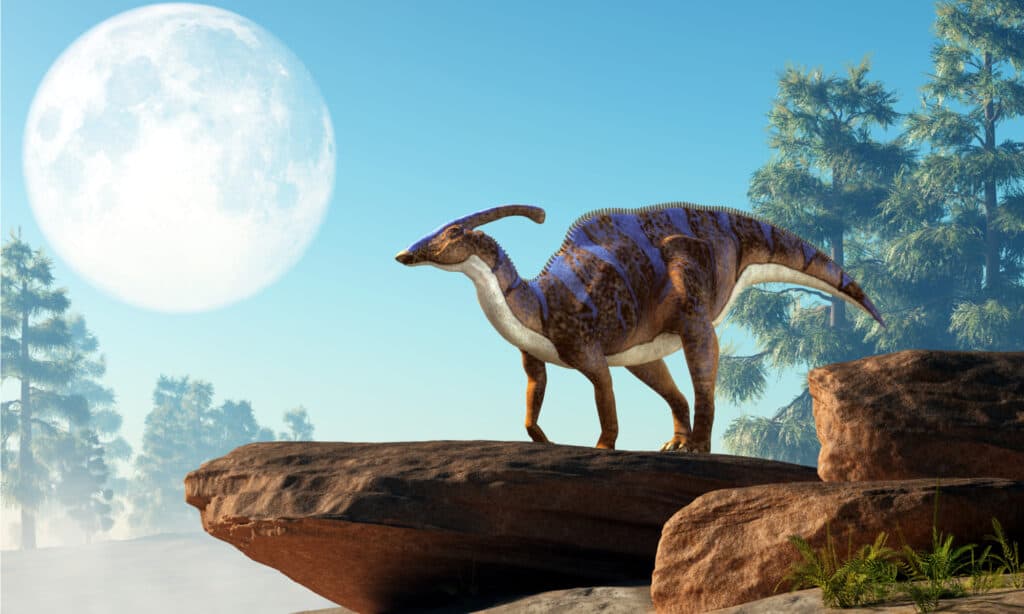
©Daniel Eskridge/Shutterstock.com
Hadrosaurs are a family of dinosaurs that lived during the Cretaceous period. These dinosaurs were native to Nevada millions of years ago. They were herbivores with large heads with long snouts full of teeth for chewing plant material. Hadrosaurs are divided into two types: duckbills and crested hadrosaurs.
Hadrosaurs were an incredibly widespread group of dinosaurs, with hundreds of species found in various parts of the world, including Nevada. They ranged from small to huge sizes, with the largest of the species reaching up to 35 feet long and weighing around 5 tons. Hadrosaurs had a unique anatomy featuring an elongated muzzle filled with specialized teeth for grinding plants, strong jaw and neck muscles, four-toed feet with hoof-like claws, a long tail for balance, and a characteristic bony crest on the head.
Hadrosaur fossils have been found across the state in places like Berlin-Ichthyosaur State Park and Tule Springs Fossil Beds National Monument. Hadrosaurs have left an impressive legacy in Nevada, which can still be seen today. The Reno-Carson City area is a particularly good place to find Hadrosaur fossils. Fossils from these dinosaurs are scattered throughout the state, providing a glimpse into what life was like millions of years ago.
2. Iguanodons
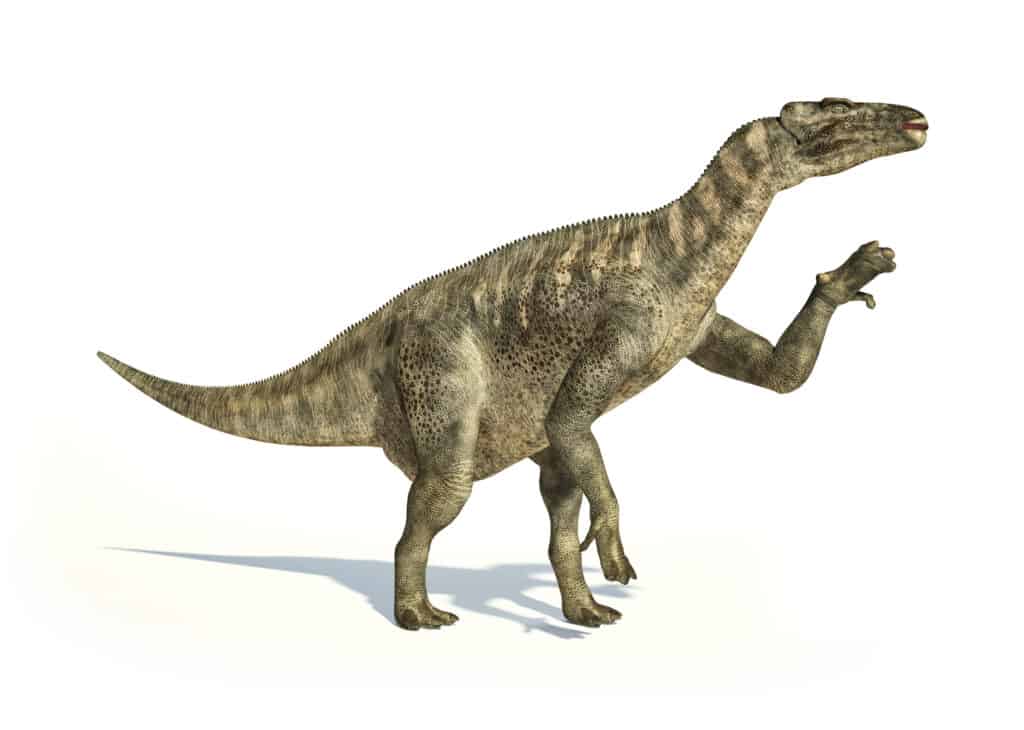
©iStock.com/leonello
Iguanodons were herbivorous dinosaurs that lived during the Jurassic and Cretaceous Periods. They could reach lengths of up to 36 feet and weighed up to 5 tons. They were one of the largest creatures to ever live in North America.
The most distinctive feature of Iguanodons is their large, beak-like bill and claws on their hands and feet that help them dig for plants and insects. They adapted to living in open areas with flat terrain, making Nevada an ideal habitat.
These dinosaurs are believed to have lived in herds, as their remains are often found in large clusters. Though they had relatively small brains compared to other dinosaurs, they are thought to have been highly intelligent creatures. In fact, some scientists believe that Iguanodons even communicated with one another through vocalization.
Iguanodons were first described in scientific detail and named by English geologist Gideon Mantell in 1825. Fossilized bones of this species have been found in parts of Nevada, though they are not as common as other dinosaurs like Tyrannosaurus rex or Triceratops.
Fossils of Iguanodons have been discovered in Nevada, including at sites such as the Sand Mountain Range. You can also see these fossils on display in the Nevada State Museum. These dinosaurs lived between 165 and 66 million years ago and are a remarkable reminder of our distant past.
3. Ankylosaurus
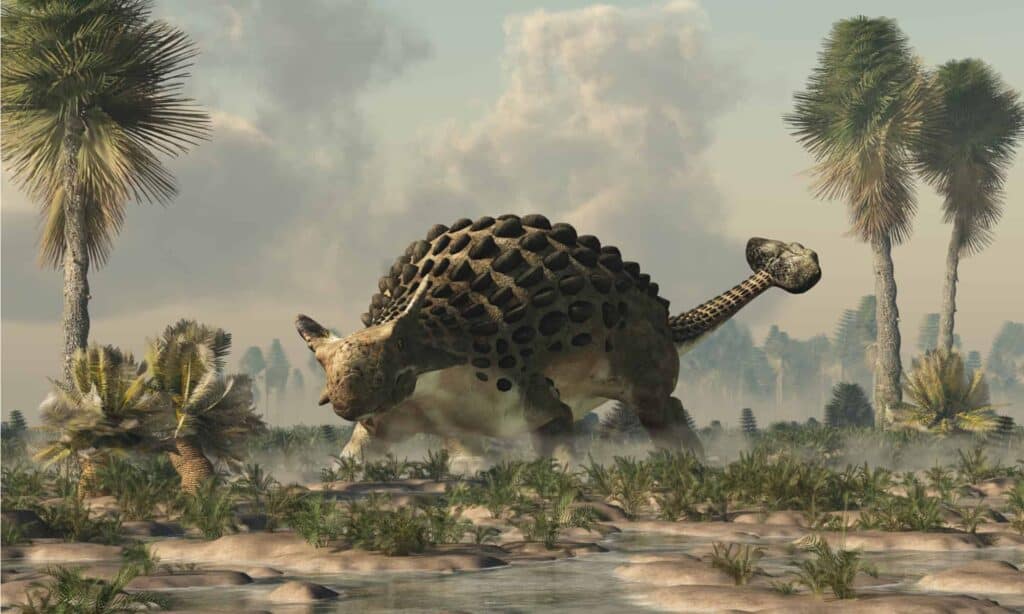
©Daniel Eskridge/Shutterstock.com
Ankylosaurus is an armored dinosaur that lived approximately 66-145 million years ago in the late Cretaceous period. It was first discovered in 1908 in the Hell Creek Formation of Montana, but fossils have since been found in South Dakota, Wyoming, and Nevada.
Ankylosaurus means “fused lizard” due to its bony armor. It is one of the largest armored dinosaurs, weighing up to 4 tons. It had a wide, flat body with small limbs, horns on its head, and a sizeable club-like tail tipped with spikes. Its clubbed tail could be used as a weapon against predators.
Ankylosaurus had bony plates embedded in its skin for protection against predators and was one of the last non-avian dinosaurs to go extinct. It is believed to have been a slow, cautious animal.
It is one of the most recognizable and iconic dinosaurs, with its unique armor-plated body. It’s a great example of how evolution made animals adapt to their environments over time.
Moreover, the Ankylosaurus fossil remains found in Nevada have provided valuable insight into the ancient lifeforms that once lived there. You can see them at the Nevada State Museum in Las Vegas.
4. Titanosaur Sauropods

.
©Dotted yeti/Shutterstock.com
Titanosaur Sauropods were some of the largest land animals ever to exist. The magnificent Titanosaur Sauropods roamed the Cretaceous period, boasting four formidable limbs and a tail to a head length of up to 110 feet.
These impressive herbivores were protected by thick skin covered with sizable bony plates and an average weight of 10-20 tons. They had long necks and tails, and their feet were wide for stability. Their back was covered in bony plates for protection from predators.
Their diet consisted of consuming plants, seeds, and leaves for sustenance. With their awe-inspiring stature, it is no surprise that these dinosaurs are remembered even today! While some predators likely hunted them, their massive size probably made it difficult for predators to make the kill, meaning predation was not a significant threat for the Titanosaur.
Titanosaur Sauropods were truly majestic creatures, and their fossils have been discovered in various locations throughout Nevada. The most notable are found in the Moenkopi Formation near the Utah border and several other areas of northwestern Nevada. In addition, these fossils can be seen at many prominent museums around the state, including the Nevada State Museum in Las Vegas.
5. Allosaurus

©Herschel Hoffmeyer/Shutterstock.com
Allosaurus was a two-legged carnivorous dinosaur that roamed the area of present-day North America during the Late Jurassic Period. Their remains have been discovered in many locations throughout Nevada, including in Elko County and at sites such as the Red Hills Mine.
Allosaurs were large predators with sharp teeth and claws that could rend flesh. They were one of the most dangerous predators of their time and had powerful tails that they could propel through the air at high speeds and use to knock over prey or other threats.
The average size of an Allosaurus was 30 feet long and 10 feet tall. Allosaurs likely hunted in packs and scavenged for food. Their sharp teeth, claws, and powerful tails helped them hunt prey.
Allosaurus was likely to have hunted in packs and scavenged for food while also preying on large herbivorous dinosaurs. Today, Allosaur fossils are displayed at the Nevada State Museum in Las Vegas.
6. Tyrannosauroids
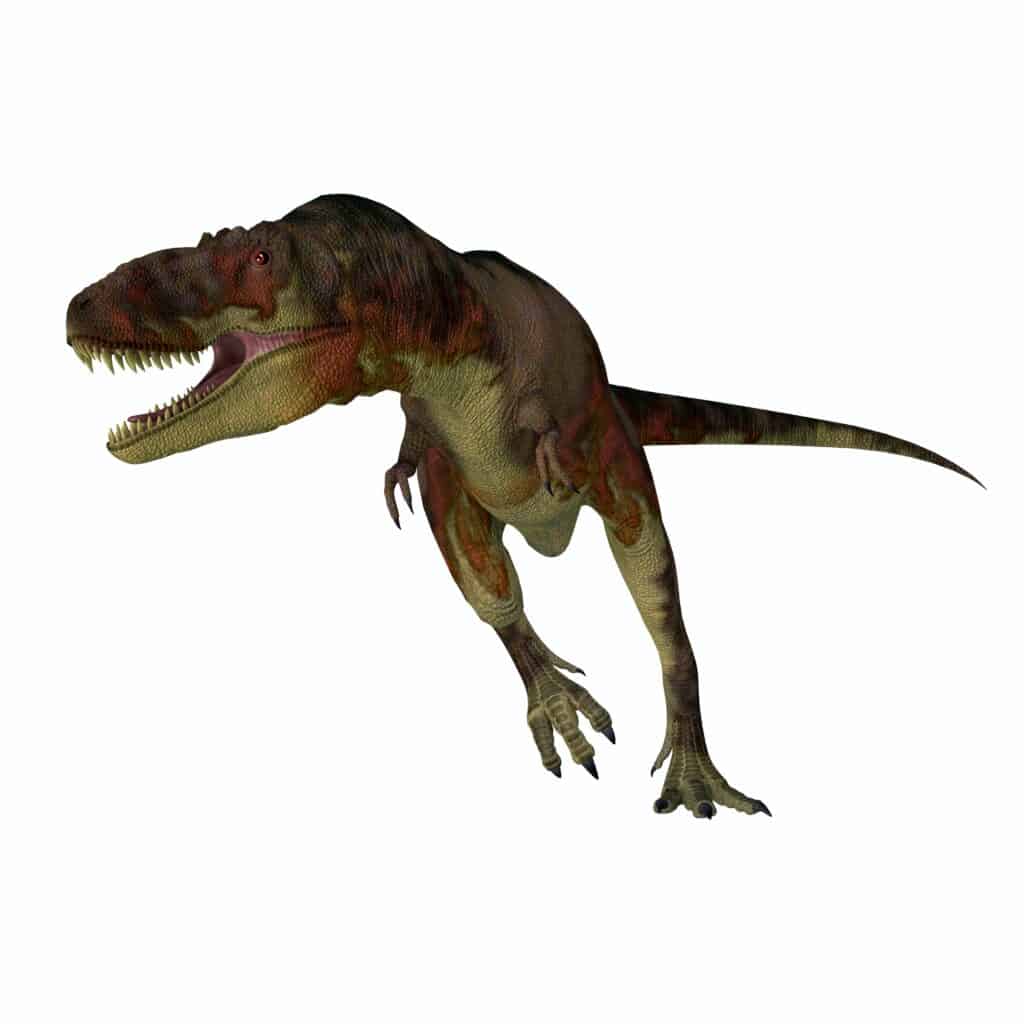
.
©Catmando/Shutterstock.com
Evidence suggests tyrannosauroids lived in Nevada for millions of years. The best-known Nevada Tyrannosauroid is the Daspletosaurus, first discovered in 1921.
Tyrannosauroids were small predatory dinosaurs that lived during the Late Cretaceous Period. They are believed to have shared a common ancestor with Tyrannosaurus Rex. Their remains have been found in various locations throughout Nevada, including at the Red Hills Mine near Elko County.
Tyrannosauroids were relatively small compared to their larger relatives. They had long arms with sharp claws for grasping prey and short, robust legs that helped them move quickly. These predators could reach speeds of up to 25 miles per hour. It had a thick skull with sharp teeth that could easily tear through flesh and bone and powerful jaws that could crush bones and shells.
Tyrannosauroids were formidable hunters who likely ate smaller animals such as lizards and mammals. Today, their fossils are found at the Las Vegas, Nevada State Museum. Other tyrannosauroids found in the Nevada area include Albertosaurus, Gorgosaurus, and Teratophoneus.
7. Hypsilophodonts
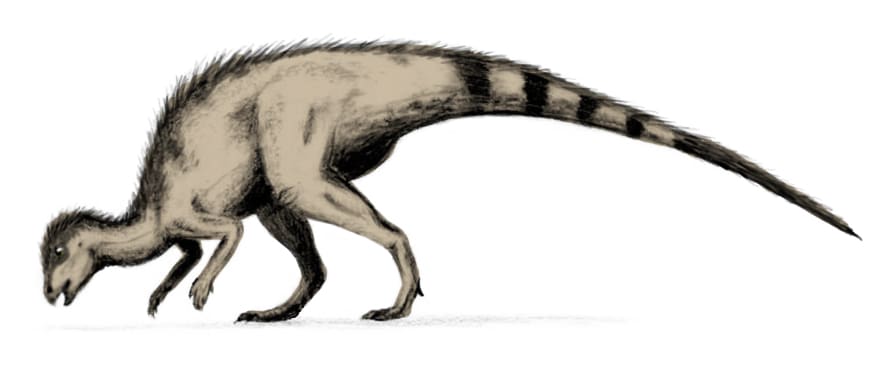
The Hypsilophodont was thought to be an Ornithischian, but that is questioned now.
©Nobu Tamura / – License
Hypsilophodonts were small to medium-sized ornithischian dinosaurs that lived approximately 99-65 million years ago during the Late Cretaceous period. They were one of the most abundant and diverse groups of non-avian dinosaurs in North America at this time, and it is estimated that they were present in what is now Nevada. They were among the last non-avian dinosaurs to exist before their eventual extinction.
These dinosaurs had a large, strong beak and two sets of cheek teeth for grinding food. The body was compact and small, usually around 2-3 feet long and weighing about 8 kilograms. They were bipedal browsers, able to move quickly on their long hind legs but also able to walk or hop on all fours.
They had short arms and five-fingered hands which could grasp things. Their tail was long and stiff, helping to balance the body when running or hopping. They were typically characterized by a relatively long neck and tail, short forelimbs and hands, five digits on each hand, a rounded skull, and a large eye socket.
They shared their habitats with other small dinosaurs, such as Othnielosaurus and Hypsirhophus. Hypsilophodonts mainly ate leaves, buds, and fruits of plants, but some species were also able to eat small animals such as insects. They had great agility and speed, being able to outrun predators such as tyrannosaurs.
Hypsilophodont fossils in Nevada are most notably found in the Gypsum Cave in Clark County. It is an important paleontological site where many other dinosaur fossils have been found. Fossilized specimens of Hypsilophodonts have also been found in other parts of Nevada, providing evidence for their presence in the state during the Late Cretaceous period.
Despite no longer being alive, these small dinosaurs have left researchers with a wealth of knowledge about their habitats and behaviors, allowing us to better understand the diversity and evolution of dinosaurs during the Late Cretaceous period.
Conclusion
Nevada has been home to many species of dinosaurs, from small predators such as Tyrannosauroids to large herbivorous sauropods. These creatures were some of the most feared and powerful animals ever seen on Earth, with sharp teeth and long claws that could rend flesh.
The remains of these prehistoric beasts can still be found in various locations across Nevada today. Understanding these fascinating creatures is essential if we want to learn more about our planet’s past – luckily, fossils are still being discovered at sites such as Red Hills Mine near Elko County or Las Vegas’ state museum, where they can be studied further.
These fossils are a great reminder of how fascinating our prehistoric past was. They also remind us that, even though these majestic creatures are no longer with us, we gain understanding from studying them. With each discovery made by paleontologists, more light is shed on how these incredible creatures lived tens of millions of years ago.
Summary of 7 Dinosaurs That Lived in Nevada
Most of the dinosaurs listed below can be viewed at the Nevada State Museum in Las Vegas.
| Dinosaur | Period | Fossil Location |
|---|---|---|
| Hadrosaurs | Cretaceous | Berlin-Ichthyosaur State Park and Tule Springs Fossil Beds National Monument |
| Iguanodons | Jurassic and Cretaceous | Sand Mountain Range |
| Ankylosaurus | Cretaceous | Nevada State Museum |
| Titanosaur Sauropods | Cretaceous | Moenkopi Formation |
| Allosaurus | Late Jurassic | Red Hills Mine |
| Tyrannosauroids | Late Cretaceous | Red Hills Mine |
| Hypsilophodonts | Late Cretaceous | Gypsum Cave in Clark County |
The photo featured at the top of this post is © Lord Beard/Shutterstock.com
Sources
- FOSSILERA, Available here: https://www.fossilera.com/pages/about-hadrosaurs
- (1970)
Thank you for reading! Have some feedback for us? Contact the AZ Animals editorial team.






